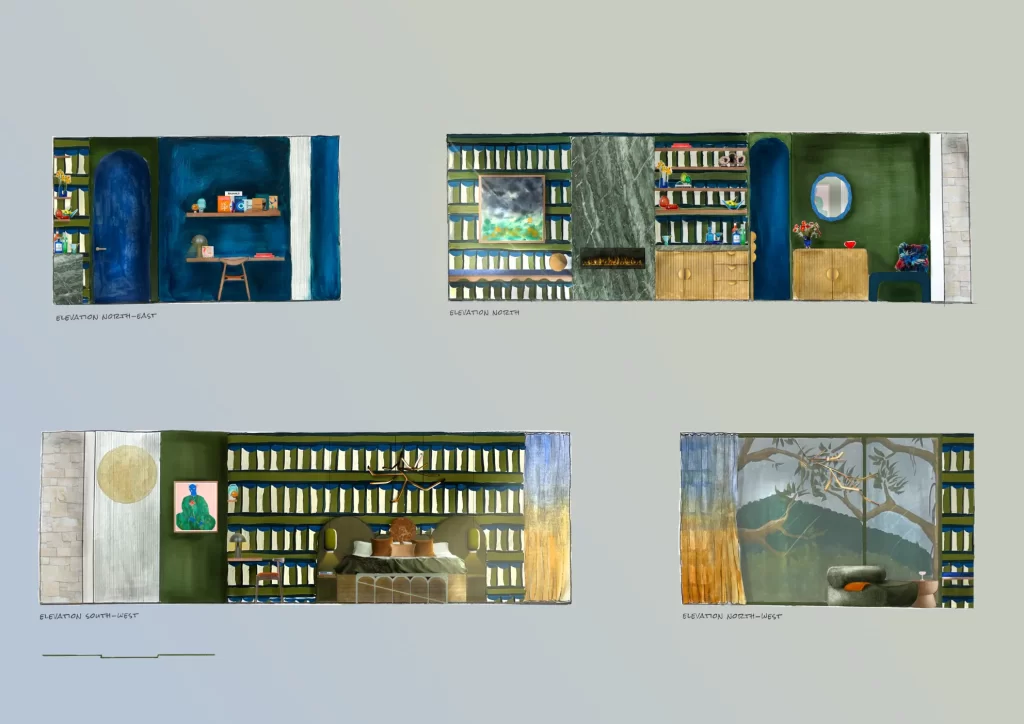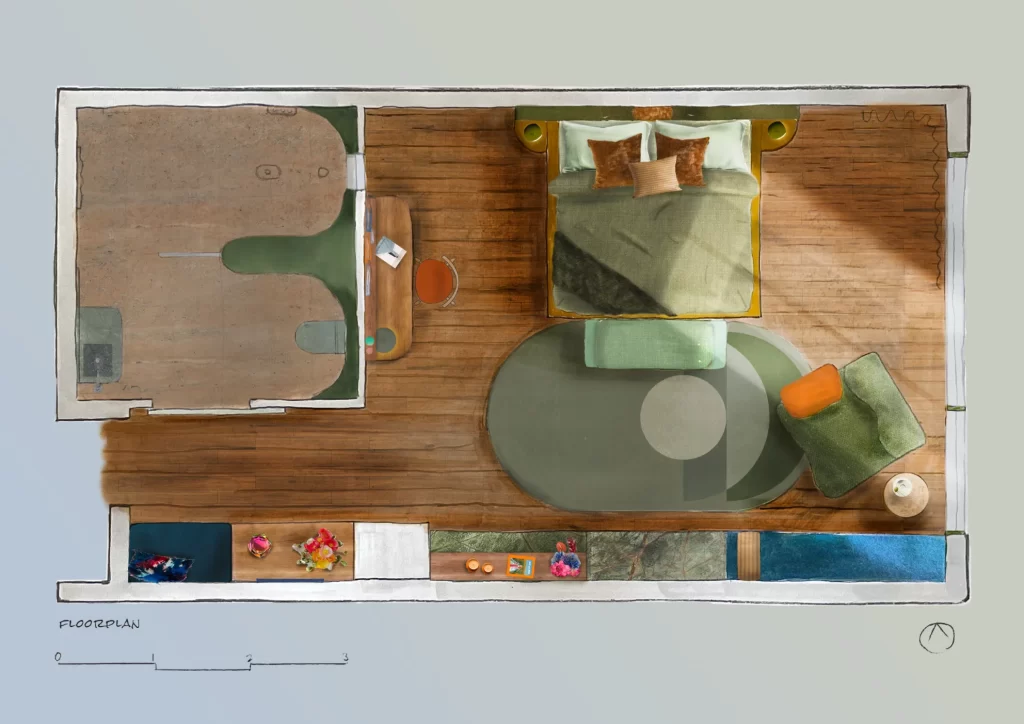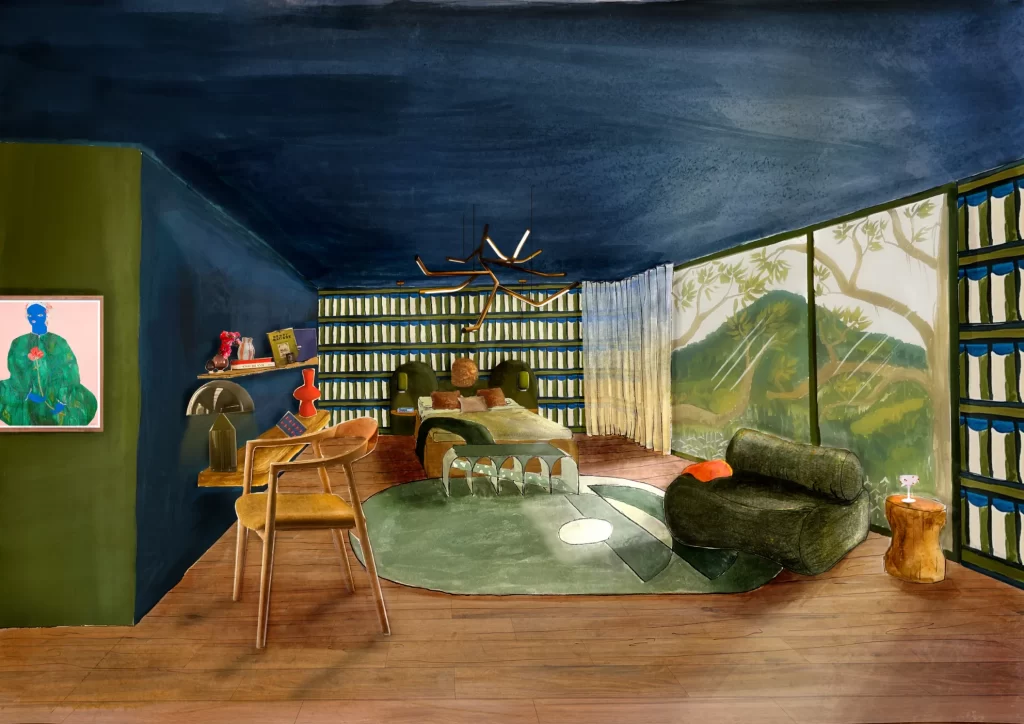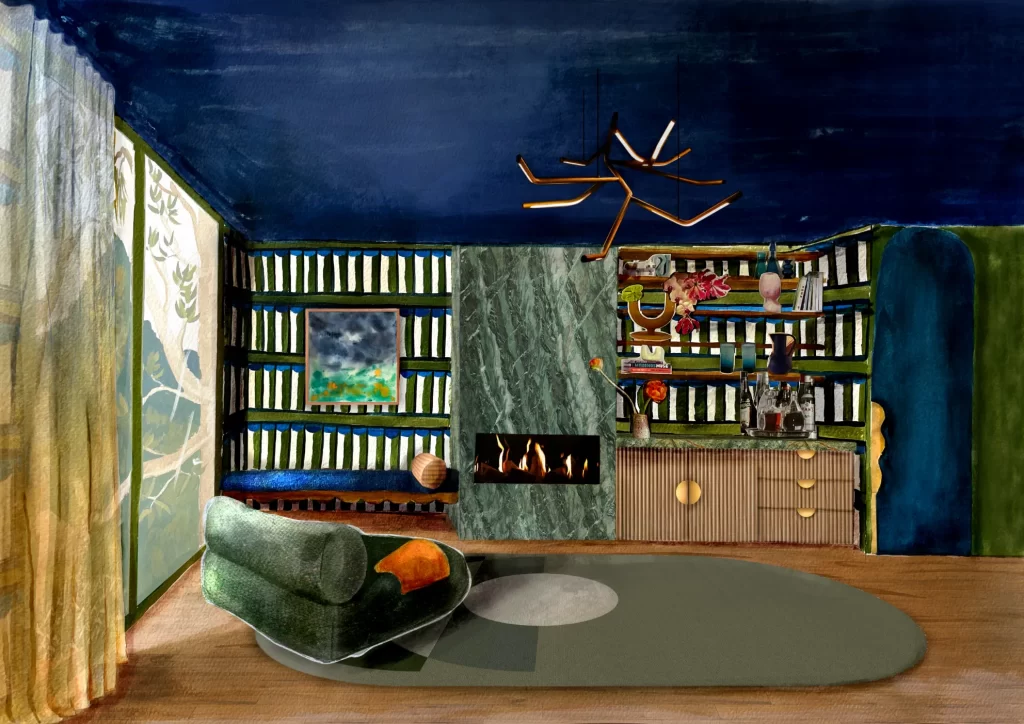BACK TO finalistS
Finalist
HUES OF MOUNT KUNANYI: BOUTIQUE HOTEL
Hues of Mount Kunanyi, a Boutique Hotel in Tasmania, has a mission: to rekindle our bond with nature and combat the white wall epidemic prevalent in hotel culture. Taking inspiration directly from nature, this design features sensory elements alongside colour psychology to harness the power of nature. This interior is crafted to awaken our primal […]

Hues of Mount Kunanyi, a Boutique Hotel in Tasmania, has a mission: to rekindle our bond with nature and combat the white wall epidemic prevalent in hotel culture. Taking inspiration directly from nature, this design features sensory elements alongside colour psychology to harness the power of nature. This interior is crafted to awaken our primal instincts, aiming to reconnect people back to Mother Nature.
With the rapid growth of urbanisation, we’ve witnessed the mass building of skyscrapers and sprawling cities, alongside technological advances that are transforming our lives. This progress, while remarkable, has unwittingly distanced us from our most primal and profound resource: Mother Nature. Urbanisation has led to a proliferation of concrete jungles where green spaces are sparse and nature feels distant. The rise of technology has tethered us to screens, captivating our attention within virtual worlds while real forests, rivers, and mountains beckon outside our windows. We have everything at our fingertips. A wood fire? No problem, we’ve got a 24/7hr video on YouTube. Moreover, the frenetic pace of modern life leaves little room for leisurely walks in the forest or moments of quiet contemplation by the river.
This loss of connection has impacted our well-being. We are natural beings, and our primal instincts tie us to nature. Numerous studies have concluded that forest bathing, the simple practice of being in a natural environment, observing nature, and breathing deeply, can help decrease stress and boost health and well-being. A person’s deminer can change instantly when being in nature: the leaves crunching underfoot, the birds singing, and the sun warming our bodies. Nature has powers that benefit us mentally and emotionally.
Within the confines of our built environments and the continuation of population growth, we have the potential to bridge the gap between humanity and nature through interiors. When thoughtfully conceived and researched, interiors designed with nature, sustainability and unique design elements in mind, can evoke the essence of being within nature, enhancing our well-being.
Hues of Mount Kunanyi Hotel draws inspiration from Mount Kunanyi, from colour, lighting, finishes and materials to create a sensory experience. Once inside, you’re welcomed by warmth, a crackling fireplace, air infused with eucalyptus and wood smoke aromas, ambient lighting and rich dark cocooning colours.
Inspired by eucalyptus leaves' the colour palette has been carefully curated to bring nature inside, while subconsciously portraying calmness and relaxation. Blue was inspired by the oil haze seen from a distance that certain eucalypt trees expel from their leaves, applying this intense colour on the ceiling spatially manipulates the space. Rich green, inspired by the leaves, used on the walls creates the feeling of being secluded. These colours invoke a sense of security and refreshment, relaxation and tranquillity, and when combined, the essence of what nature can restore within us is achieved. These blues and greens are balanced and illuminated by the radiant glow of orange, inspired by the sandstone rock formations at sunset, which glow in variations of warm tones, showcasing the ever-changing beauty of nature.
The design seamlessly integrates organic forms, such as the scalloped timber joinery and natural textures. Each material was carefully considered to emanate the mountain’s rugged formations juxtaposed with softness. Every corner invites touch, from the smooth, cool surfaces reminiscent of rocks to the plush fabrics that mimic the gentle sway of eucalyptus leaves in the breeze.
Lighting plays an integral part in the design. Soft, warm lighting mimics the sun’s movements. The pendant suspended from the ceiling, like a tree branch, casts shadows across the ceiling. The painted walls, finished in Roman clay, mirror the imperfection of the landscape. When sunlight filters through the sheer ombre curtains, the imperfections highlighted in the plaster are reminiscent of the dappled light cast by leaves. Furthermore, integrating natural light into the interior maximising access to daylight and minimising artificial lighting, blurs the boundaries between indoors and outdoors.
Sustainability and localism are not just guiding principles, but the very essence of this design ethos. At the heart, the vision is an estimated 15 meticulously crafted boutique apartments, each embodying principles of passive house design. This hotel aspires to lead the charge in reducing the construction footprint on the environment and revitalising existing urban areas. Creating a sanctuary of luxury while cultivating environmental stewardship.
Our disconnect from nature is a pressing challenge of our time, but it’s not insurmountable. With thoughtful interior design that celebrates and integrates natural elements, especially through colour and sensory materials, we can bridge our divide with nature and increase well-being. Hues of Mount Kunanyi celebrates the unique environmental features of its location, standing in stark contrast to the typical white-walled hotel room. By drawing inspiration from nature and incorporating elements that benefit our well-being we can ultimately change the landscape of design and better lives.








Showcase your design to an international audience
SUBMIT NOW
Image: Agrapolis Urban Permaculture Farm by David Johanes Palar
Top
Hues of Mount Kunanyi, a Boutique Hotel in Tasmania, has a mission: to rekindle our bond with nature and combat the white wall epidemic prevalent in hotel culture. Taking inspiration directly from nature, this design features sensory elements alongside colour psychology to harness the power of nature. This interior is crafted to awaken our primal instincts, aiming to reconnect people back to Mother Nature. With the rapid growth of urbanisation, we’ve witnessed the mass building of skyscrapers and sprawling cities, alongside technological advances that are transforming our lives. This progress, while remarkable, has unwittingly distanced us from our most primal and profound resource: Mother Nature. Urbanisation has led to a proliferation of concrete jungles where green spaces are sparse and nature feels distant. The rise of technology has tethered us to screens, captivating our attention within virtual worlds while real forests, rivers, and mountains beckon outside our windows. We have everything at our fingertips. A wood fire? No problem, we’ve got a 24/7hr video on YouTube. Moreover, the frenetic pace of modern life leaves little room for leisurely walks in the forest or moments of quiet contemplation by the river. This loss of connection has impacted our well-being. We are natural beings, and our primal instincts tie us to nature. Numerous studies have concluded that forest bathing, the simple practice of being in a natural environment, observing nature, and breathing deeply, can help decrease stress and boost health and well-being. A person’s deminer can change instantly when being in nature: the leaves crunching underfoot, the birds singing, and the sun warming our bodies. Nature has powers that benefit us mentally and emotionally. Within the confines of our built environments and the continuation of population growth, we have the potential to bridge the gap between humanity and nature through interiors. When thoughtfully conceived and researched, interiors designed with nature, sustainability and unique design elements in mind, can evoke the essence of being within nature, enhancing our well-being. Hues of Mount Kunanyi Hotel draws inspiration from Mount Kunanyi, from colour, lighting, finishes and materials to create a sensory experience. Once inside, you’re welcomed by warmth, a crackling fireplace, air infused with eucalyptus and wood smoke aromas, ambient lighting and rich dark cocooning colours. Inspired by eucalyptus leaves' the colour palette has been carefully curated to bring nature inside, while subconsciously portraying calmness and relaxation. Blue was inspired by the oil haze seen from a distance that certain eucalypt trees expel from their leaves, applying this intense colour on the ceiling spatially manipulates the space. Rich green, inspired by the leaves, used on the walls creates the feeling of being secluded. These colours invoke a sense of security and refreshment, relaxation and tranquillity, and when combined, the essence of what nature can restore within us is achieved. These blues and greens are balanced and illuminated by the radiant glow of orange, inspired by the sandstone rock formations at sunset, which glow in variations of warm tones, showcasing the ever-changing beauty of nature. The design seamlessly integrates organic forms, such as the scalloped timber joinery and natural textures. Each material was carefully considered to emanate the mountain’s rugged formations juxtaposed with softness. Every corner invites touch, from the smooth, cool surfaces reminiscent of rocks to the plush fabrics that mimic the gentle sway of eucalyptus leaves in the breeze. Lighting plays an integral part in the design. Soft, warm lighting mimics the sun’s movements. The pendant suspended from the ceiling, like a tree branch, casts shadows across the ceiling. The painted walls, finished in Roman clay, mirror the imperfection of the landscape. When sunlight filters through the sheer ombre curtains, the imperfections highlighted in the plaster are reminiscent of the dappled light cast by leaves. Furthermore, integrating natural light into the interior maximising access to daylight and minimising artificial lighting, blurs the boundaries between indoors and outdoors. Sustainability and localism are not just guiding principles, but the very essence of this design ethos. At the heart, the vision is an estimated 15 meticulously crafted boutique apartments, each embodying principles of passive house design. This hotel aspires to lead the charge in reducing the construction footprint on the environment and revitalising existing urban areas. Creating a sanctuary of luxury while cultivating environmental stewardship. Our disconnect from nature is a pressing challenge of our time, but it’s not insurmountable. With thoughtful interior design that celebrates and integrates natural elements, especially through colour and sensory materials, we can bridge our divide with nature and increase well-being. Hues of Mount Kunanyi celebrates the unique environmental features of its location, standing in stark contrast to the typical white-walled hotel room. By drawing inspiration from nature and incorporating elements that benefit our well-being we can ultimately change the landscape of design and better lives.







